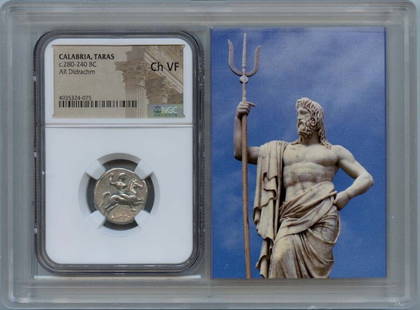Popular Searches
Popular Searches

Cyrenaica, Ancient Greece (BC 631-525), miniature coin
Similar Sale History

Recommended Items









Item Details
Description
Cyrenaica, Ancient Greece (BC 631-525), rare miniature coin trihemiobol (?), 1.12g, with silphium plant;Weight: 1.12 g;Diameter: 7-9 mm;Greek cities:During the Ramesside period (thirteenth century BC), the Libu and the Meshwesh were tribes of the area of Cyrenaica which are mentioned in Egyptian records as making frequent incursions into the New Kingdom of Egypt.Cyrenaica was colonized by the Greeks beginning in the 7th century B.C. The first and most important colony was that of Cyrene, established in about 631 BCE by colonists from the Greek island of Thera. They had left their island because of a severe famine. Their commander Aristoteles took the Libyan name Battos. His dynasty, the Battaid, persisted in spite of heavy resistance by the Greeks in neighboring cities.The east of the province was called Marmarica (no major city), but the important part was in the west, comprising five cities, hence known as the Pentapolis: Cyrene (near the modern village of Shahat) with its port of Apollonia (Marsa Susa), Arsinoe or Taucheira (Tocra), Euesperides or Berenice (near modern Benghazi), Balagrae (Bayda) and Barce (Marj) – of which the chief was the eponymous Cyrene. The term "Pentapolis" continued to be used as a synonym for Cyrenaica. In the south the Pentapolis faded into the Saharan tribal areas, including the pharaonic oracle of Ammonium.The region produced barley, wheat, olive oil, wine, figs, apples, wool, sheep, cattle, and silphium, an herb that grew only in Cyrenaica and was regarded as a medicinal cure and aphrodisiac. Cyrene became one of the greatest intellectual and artistic centers of the Greek world, famous for its medical school, learned academies, and architecture, which included some of the finest examples of the Hellenistic style. The Cyrenaics, a school of thinkers who expounded a doctrine of moral cheerfulness that defined happiness as the sum of human pleasures, were founded by Aristippus of Cyrene[17] Other notable natives of Cyrene were the poet Callimachus and the mathematicians Theodorus and Eratosthenes.[16]In 525 BCE, after taking Egypt, the Persians took the Pentapolis. They were followed by Alexander the Great in 332 BCE, who received tribute from these cities after he took Egypt.[14] The Pentapolis was formally annexed by Ptolemy I Soter and it passed to the diadoch dynasty of the Lagids, better known as the Ptolemaic dynasty. It briefly gained independence under Magas of Cyrene, stepson of Ptolemy I, but was reabsorbed into the Ptolemaic empire after his death. It was separated from the main kingdom by Ptolemy VIII and given to his son Ptolemy Apion, who, dying without heirs in 96 BCE, bequeathed it to the Roman Republic.
Buyer's Premium
- 0%
Cyrenaica, Ancient Greece (BC 631-525), miniature coin
Estimate $1,200 - $2,500
2 bidders are watching this item.
Get approved to bid.
Shipping & Pickup Options
Item located in Tampa, FL, usSee Policy for Shipping
Payment

Related Searches
TOP














































